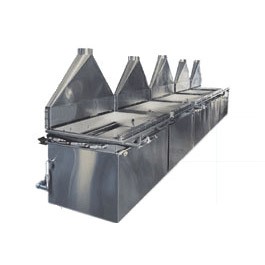
In order to assure the integrity of die cast parts, it is crucial to have a reliable and effective die cast mold cleaning process in place. When it comes to die cast mold cleaning, the typical design characteristics of molding equipment present some unique application challenges. The Blackstone-NEY line of Atlantis® Ultrasonic Systems provides a dependable and highly effective means for meeting these challenges.
The complex design of die cast molds makes die cast mold cleaning difficult. Die casting molds typically have many internal channels for the releasing of gases during the molding process. The mold cleaning process must involve the proper submersion of the mold so that each of the channels fills and is sufficiently cleaned on the inside. These areas must also be properly drained before moving on to the rinse cycle and drying cycle. Failure to adequately drain the channels in the cast mold could result in dirt becoming trapped within the mold. The sheer weight and density of die casting molds also makes cleaning a challenge.

A thorough plastic injection mold maintenance program is critical to the success of any injection molding operation. A plastic injection mold must be on a consistent schedule of planned downtime for maintenance, including inspection and repair to prevent problems with equipment and product quality. Plastic injection mold cleaning is an important part of that maintenance process.
When it comes to cleaning plastic injection molds, the ultrasonic cleaning method offers significant advantages over hand cleaning. The manual cleaning of injection molds can require scrubbing and other abrasive actions, which can be damaging to the mold surfaces. Ultrasonic cleaning offers a superior alternative by cleaning through cavitation. Cavitation refers to the rapid formation and collapse of millions of extremely small bubbles, which are produced in a water bath using ultrasonic waves and a biodegradable cleaner. The bubbles effectively “scrub” all of the surfaces of the mold including any grooves, channels and crevices. The ultrasonic process has a demonstrated record of effectiveness in removing contaminants and residues, releasing burnt resins, and venting outgas without compromising the surface of the mold.
Blackstone-NEY Ultrasonics, a world leader in providing cleaning and waste minimization technologies, will introduce a host of advanced cleaning solutions at the MD&M West 2018 in Anaheim, California February 6 - 8, 2018. Visitors to Blackstone-NEY Ultrasonics Booth #1167 will be introducing a number of new products, technologies and services. Among the new technologies exhibited at the show will be:

Ransohoff, a recognized leader in cleaning technology, will introduce a host of advanced cleaning solutions at the Shot Show Showcase in Las Vegas, NV January 22 – 23rd, 2018. Visitors to Ransohoff Booth #S1620, will see the popular Durm Cleaning System tanks with new features, along with many more cleaning solutions.
High Volume Continuous Cleaning: Cup and Cases, Primer Caps and Anvils
Utilizing both spray and immersion technology, our Ransohoff drum washers are the fast, highly
effective continuous cleaning solution for cup and cases as well as primer caps and anvils, whether for pre-annealing, brightening and/or final cleaning.
Ransohoff Lean Jet RB-1 Immersion Cleaning
These systems clean using our patented parts washing and rinsing process of agitation, spray impingement, rotation, hydraulic purging through immersion, and heated blow-off drying. This machine is ideal for small, precision parts such as primer caps and anvils.
Ultrasonic Cleaning: Firearm Components
Blackstone-NEY Ultrasonics is a leading provider of precision ultrasonic cleaning equipment for firearm components such as barrels, triggers, magazines, and scopes. Our ultrasonic cleaning technology is also ideal for suppressors and silencers, considering they can be cleaned without disassembly, and at optimum frequencies to minimize erosion.
Four Questions to Ask in Evaluating your Parts Cleaning Equipment
- Was the current system designed to wash the parts it is currently washing?
- Are the parts meeting the required level of cleanliness?
- Is the current system meeting needs efficiently?
- Are you able to meet schedule requirements with the current system?
Too often, many operations rely on a parts cleaning system that is just getting them by. When considering whether or not your parts cleaning system is meeting your needs, you must evaluate how effective, efficient, and economical it is, as well as whether or not the process integrates well with your work flow. Thorough evaluation of your parts cleaning process could lead to making some very productive and profitable improvements to your operation.
Many companies rely on inefficient manual parts cleaning methods, simply because that is the way parts cleaning has always been done. When considering updating from manual cleaning to a parts cleaning system, many companies are deterred by idea of buying new equipment to do something they are already getting done. However, when compared with the costs of manual cleaning in terms of labor and consumable cleaning supplies, parts cleaning equipment can be a much more cost effective option. If chemicals are involved in the cleaning process, parts cleaning equipment also limits or eliminates employee exposure to those chemicals, creating a safer and healthier work environment.
When planning for new parts cleaning equipment you are likely to focus on equipment capabilities and how the new equipment will meet your needs. While these are essential considerations, there is another factor to consider that is often overlooked until it is too late – designing for floor space efficiency.
Planning for the installation of any new equipment, including a parts cleaning system, must not only involve finding space, but planning for that space. Without proper planning, your new parts cleaning equipment may not be optimized for efficiency. Things to consider include:
- Ease of access
- Elimination of bottlenecks
- Smooth workflow
- Logistical planning for water and power access
- Flexibility for future growth or change
Fortunately there are a wide range of configuration options available for implementing parts cleaning equipment within your facility. Options include standalone units, conveyor lines, and automated systems. As you consider your work space requirements, you can also consider these different configurations and how they will fit into your plan.
CTG would like to congratulate all the employees from Ransohoff who celebrated a birthday in September and October!
September

October

The cleaning of parts is a comprehensive process, which typically includes three key steps: washing, rinsing, and drying. Many people don't realize that the options available for each of these steps are as diverse as the parts involved. It is important to select the right technologies suited to the part for each phase of the parts cleaning process.
It may be difficult to discern the individual steps in some applications due to overlap, however the following provides a breakdown of each step:
Washing
The dissolution or displacement of contamination from parts happens during the washing phase. In most cases this is accomplished through the use of water mixed with a specialized chemical formula or a solvent. In some applications, washing may by a multi-step process, depending on the contaminants involved. In the case of heavy contaminant load, a pre-clean step and a second cleaning cycle may be required to complete the washing process. No matter what methods are used, at the end of the washing step, all contaminants should be completely removed from the parts and separated from the parts to the greatest extent possible.
Rinsing
Blackstone-NEY Ultrasonic exhibited the GMC 3523 at the SEMA show in the Safety-Kleen Booth. Some of the celebrities that were in the booth included Graveyard Carz and Richard Petty. Stop by the booth and see who shows up next!


Advanced technologies require an extremely high degree of component cleanliness. Ultrasonic technology has provided a highly effective solution to meeting precision cleaning needs. Cutting edge ultrasonic cleaning technologies are used in the most demanding OEM markets to remove sub-micron particles from components used in electronics, medical devices, and other critical applications.
Ultrasonic Waves
Understanding ultrasonic cleaning begins with looking at the science behind it. The vibration of an object causes sound waves that make the air molecules around the object vibrate. When those vibrations travel through the air they cause vibrations in the human ear, which the brain interprets as sound. Sound waves transmitted at 20,000 Hz or higher are considered ultrasonic waves. These vibrations are rapid enough to create a pitch so high it cannot be heard by the human ear. In nature, certain animals are able to perceive ultrasonic waves and use them to communicate.
Ultrasonic Cleaning
In terms of technology, it has been discovered that ultrasonic waves can be used for highly effective, chemical-free cleaning. Ultrasonic waves are created by a high-frequency electronic generator and transmitted through water in a tank specially engineered for parts cleaning. Alternating waves of expansion and compression occur within the water. The water is actually torn apart during the expansion phase to create cavitation bubbles, which do the actual ultrasonic cleaning work.
Cavitation Bubbles



 English
English Spanish
Spanish Chinese
Chinese Canada
Canada Mexico
Mexico United Kingdom
United Kingdom




